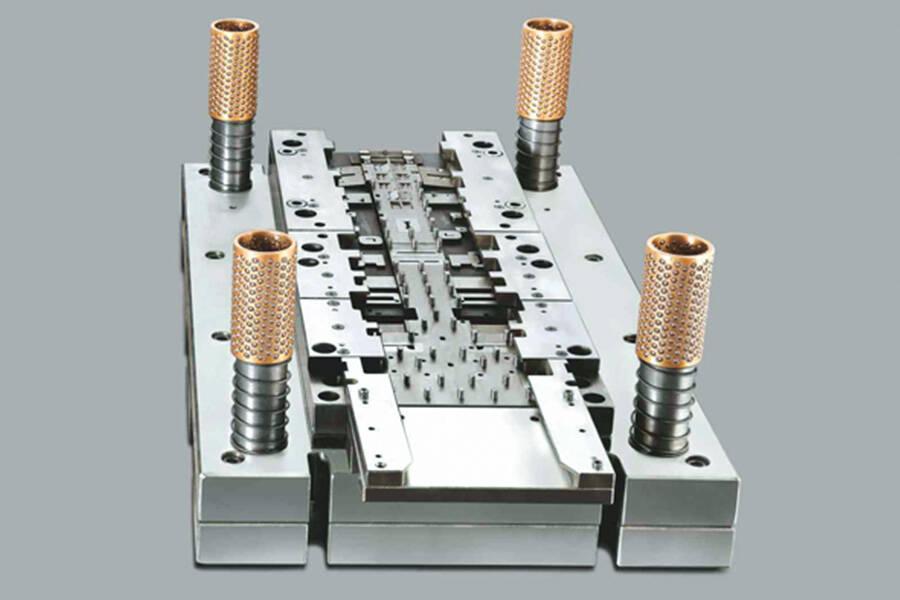In the wave of modern manufacturing,Progressive The Stamping, as an efficient and precise metal forming technology, is playing a pivotal role. This process not only represents technological progress in the metal processing industry, but is also an important cornerstone for the production of high-volume, high-precision parts. This article aims to deeply explore the connotation, working principle, application fields and uniqueadvantages of progressive die stamping, in order to unveil this mysterious and powerful processing technology for readers.
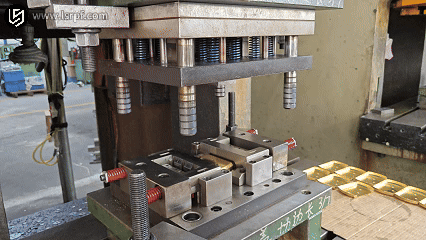
What is Progressive Die Stamping?
Progressive die stamping, as the name suggests, uses a complex mold structure to achieve multiple,multi-step stamping processingof metal sheets in a continuous process flow. This technology breaks the limitations of traditional single-station stamping, integrates multiple processes into one mold, and realizes continuous operations from material feeding, preliminary blanking, complex bending, stretch forming to final cutting. Every step of the operation is closely connected, like a precision automated machine, gradually transforming metal sheets into finished parts that meet the design requirements.
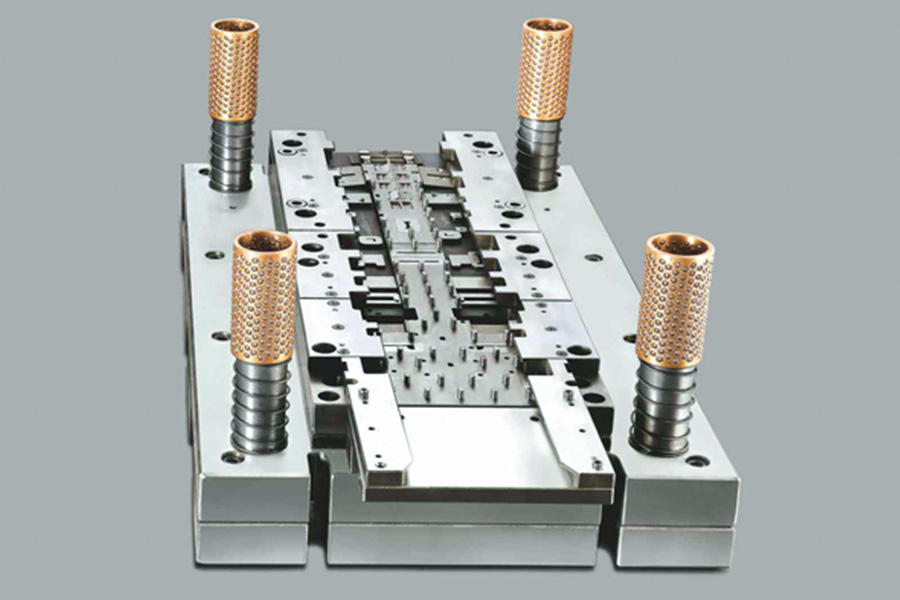
What is the working principle of progressive die stamping?
Theworking process of progressive die stampingis relatively complex but efficient. First, the material to be processed (usually a long sheet) is fed into the mold. These materials can be strips cut to a certain width in advance, or rolls. Especially in mass production, rolls are more popular because of their automatic feeding and rewinding characteristics. During the stamping process, the press completes the stamping of one or more workpieces in each stroke, and at the same time, the strip moves forward according to a fixed step under the control of the automatic feeding mechanism. In this way, multiple processes such as punching, bending, drawing, and forming can be completed sequentially on one mold.
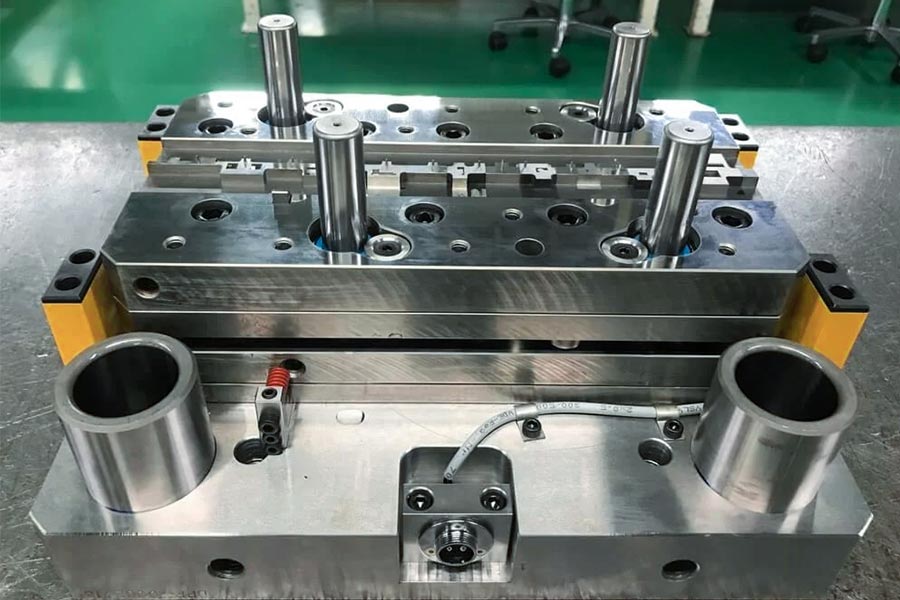
What materials are suitable for progressive die stamping?
As an efficient and precise metal forming technology,progressive die stamping is widely used in the manufacturing industry. A wide variety of materials are used, depending primarily on the specific requirements of the part to be produced, cost considerations and the machinability of the material. The following are some commonprogressive die stamping materials:
1. Steel
| Alloy tool steel | Carbide steel | High speed steel |
|
|
|
2. Non-ferrous metals
| Aluminum | Copper and copper alloys (such as brass) |
|
|
3. Special alloys
| Stainless steel | Titanium alloy |
|
|
What Industries Use Progressive Die Stamping?
Progressive die stamping is a kind of stamping process, which is widely used in the production and processing of automated, large-scale stamping parts. Its applications include but are not limited to the following areas:
- Aerospace:In the aerospace sector,progressive die stamping is used to produce a variety of precision spacecraft parts. These components require high precision and reliability to ensure the performance and safety of the spacecraft.
Electronic products: Metal shells, connectors and other components commonly found in electronic products are often produced by progressive die stamping. This production method can ensure the precision and consistency of the components, and improve the quality and competitiveness of the product. - Automotive industry:The automotive industry is one of the important application areas for progressive die stamping. From the panels of the car body to the metal structural parts inside, many parts are produced by progressive die stamping. This production method can significantly improve production efficiency, reduce production costs, and ensure the accuracy and reliability of parts.
- Medical devices:In the field of medical devices,progressive die stamping is used to produce a variety of precision medical device parts. These components require high precision and cleanliness to ensure the performance and safety of medical devices.
- Agriculture:Agricultural machinery and equipment also require a large number of metal parts, which can also be produced by progressive die stamping. This production method ensures the accuracy and consistency of parts and components, and improves the performance and reliability of agricultural machinery.
What are the advantages and disadvantages of progressive die stamping?
As an efficient metal forming technology,progressive die stamping has wide applicationsin the manufacturing industry. The following are the mainadvantages and disadvantages of progressive die stamping:
Advantages
Progressive die stamping has several advantages over other stamping methods, such as four-slide or multi-slide machines.
- Less time to set up:Progressive die stamping takes 38% less time to set up than multi-slide stamping. This allows producers to generate smaller lot sizes and make manufacturing scheduling more flexible to produce what the client wants when they need it. It also reduces the labor involved in the production of parts.
- Repeatability:The machines provide excellent repeatability with tight tolerances. They can generate large quantities of parts without compromising quality.
- High accuracy:Because each station performs a different operation, progressive die stamping is highly efficient and can be used to produce large quantities of parts with a high degree of accuracy.
- Generic Tooling:Because of the simple nature of the forming process, using only vertical pressure, it is possible to move tooling from one supplier to another without the need for a major retrofit. Generally if a press machine of the same tonnage and bed size is available a tool build to run on that bed size and tonnage will be able to run in a different press.
Disadvantages
While there are many advantages to using progressive die stamping for sheet metal fabrication, there are also some drawbacks to consider:
- Expense:One of the biggest disadvantages is the high initial investment cost. Die sets for progressive die stamping can be very costly, and businesses need to be sure that they can generate enough work to justify the expense.
- Limited operations:Progressive die stamping can only be used for certain projects. Some part features may not be possible to produce inside a progressive die.
- Continuity:Finally, progressive die stamping can be very complex and time-consuming (especially since setups have to be configured or reconfigured for each project). This makes it hard to switch between projects quickly.
- More waste:Progressive die stamping produces waste. Due to the fact that the part must be carried on the strip throughout the entire process there is inherent waste caused by the material needed to keep the part on the strip until the very last step. Although the waste material can be recycled, when working with material such as copper or brass this process can be less cost effective.
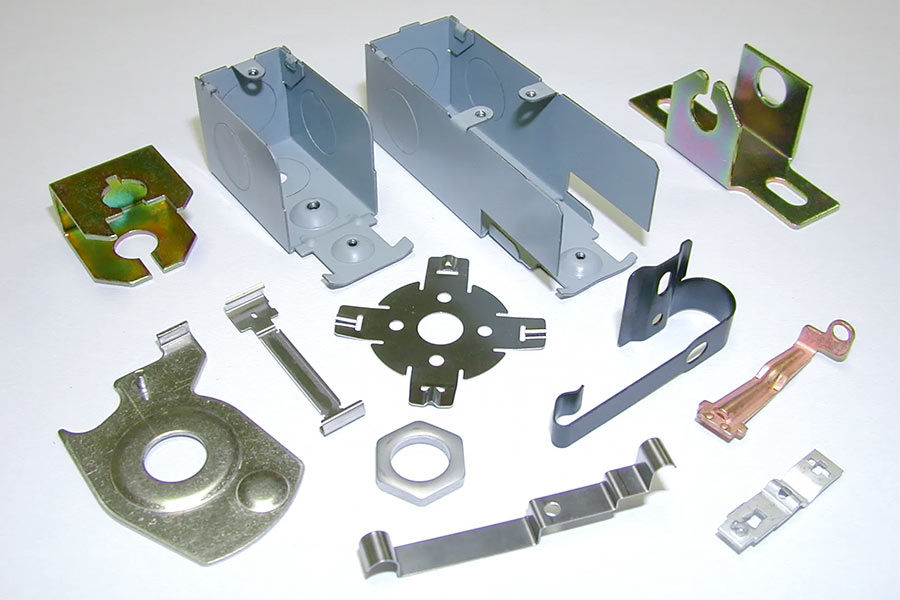
Comparison of Progressive Die Stamping and Other Stamping Methods
1.Progressive Die Stamping vs. Single-Stage Stamping:
Progressive Die Stamping:As we’ve explored, this method involves multiple stages, allowing the completion of several operations within one machine cycle. It’s ideal for high-volume production and is known for its efficiency and consistency in producing complex parts.
Single-Stage Stamping:This method uses one die for each operation, requiring the workpiece to be moved between different presses for each task. It’s more straightforward and more cost-effective for low-volume production or parts that don’t need multiple operations.
2.Progressive Die Stamping vs. Transfer Die Stamping:
Progressive Die Stamping:The metal strip is fed through a series of stations within a single die. This method is highly efficient for creating smaller parts and is excellent for long production runs.
Transfer Die Stamping:In this method, individual parts are transferred from one station to another within the press. It’s more suitable for larger, heavier components and offers more flexibility for complex geometries. However, it’s generally slower and less efficient for high-volume production than progressive die stamping.
3.Progressive Die Stamping vs. Fine Blanking:
Progressive Die Stamping:Known for its ability to produce parts with various features and forms in one pass, it’s highly efficient but might have limitations in achieving the ultra-smooth edges and flatness some applications require.
Fine Blanking:This method is specialized for producing parts with very smooth edges and precise flatness. It’s ideal for parts that require a high degree of accuracy and a clean finish, but it could be more efficient for complex geometries or high-volume production.
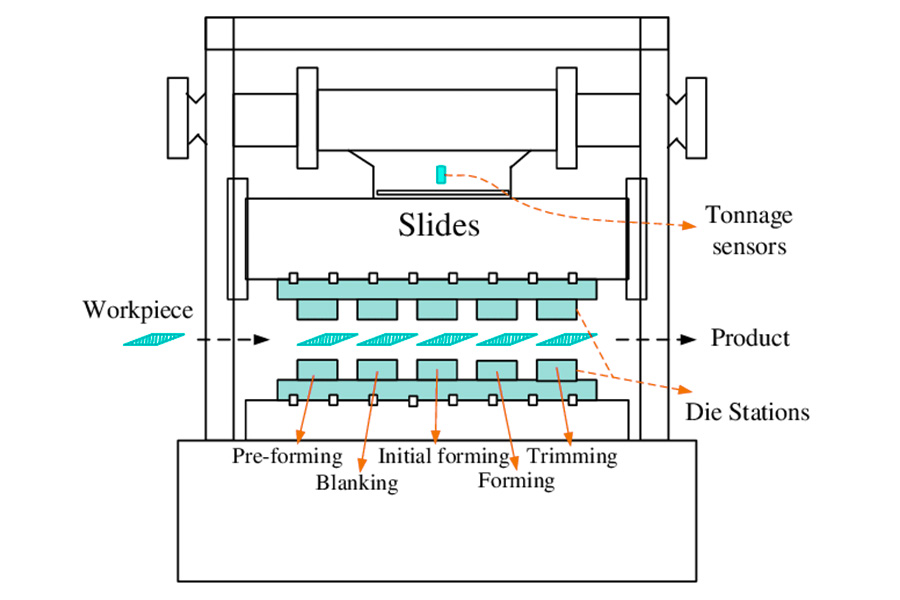
FAQs
1.What is progressive die stamping?
Progressive die stamping is a metal stamping processthat uses a progressive die (also called a continuous die, jump die, or multi-station progressive die) to perform multiple operations in a single stamping process. This kind of mold design contains multiple stations, each station is connected in sequence to complete different processes, and a series of different stamping processes can be completed in one stroke of the punch press.
2.What is the difference between progressive die stamping and single die stamping?
The maindifference between progressive die stamping and single die stampingis the number of operations they can perform in a single press pass. Progressive die stamping: It can automatically perform multiple operations, such as punching, bending, drawing and forming, etc. These operations can be completed continuously at different stations of a set of molds. Single-die stamping: Each setup performs only one operation, usually only completing a simple stamping process such as punching or blanking.
3.Which materials are suitable for progressive die stamping?
Progressive die stamping is suitable for a variety of materials, including but not limited to: Steel: including low carbon steel, medium carbon steel and high carbon steel, etc., with good stamping performance and processability. Aluminum: Aluminum alloy has lighter weight and good corrosion resistance, making it suitable for products that need to reduce weight. Brass: It has good processing properties and corrosion resistance, and is often used to make decorative parts and electrical parts. Special alloys: such as stainless steel, titanium alloys, etc., although they are more difficult to process, they can be achieved through special stamping processes and mold designs.
4.What are the advantages of progressive die stamping?
Progressive die stamping has several advantagesthat make it the preferred process for high-volume metal parts production: High efficiency: Since multiple processes can be completed in one mold, intermediate transfers and repeated positioning work are significantly reduced, coupled with automatic feeding The mechanism can realize high-speed and automatic stamping, thus improving production efficiency. Low cost: Due to high productivity and automation, less equipment and operators are required, so the cost is relatively low in mass production. Good consistency in mass production: The progressive mold completes all the forming processes of the workpiece in one mold, overcoming the operational inconvenience and accumulated errors caused by multiple positioning when using a single-process mold, thus ensuring the consistency of mass production.
Summary
As an efficient and automatedstamping processing technology, progressive die stamping plays an increasingly important role in modern manufacturing. By precisely controlling the feed step and the cumulative error between each station, the progressive die can produce high-precision, high-quality stamping parts that meet various complex shapes and process requirements. However, due to its complex structure and high manufacturing precision, the cost of progressive molds is relatively high and is more suitable for mass production. Therefore, when choosing whether to use progressive die stamping, multiple factors such as production needs, material properties, equipment conditions, and maintenance costs need to be comprehensively considered.
Disclaimer
The content on this page is for reference only.LSdoes not make any express or implied representation or warranty as to the accuracy, completeness or validity of the information. No performance parameters, geometric tolerances, specific design features, material quality and type or workmanship should be inferred as to what a third party supplier or manufacturer will deliver through the Longsheng Network. It is the responsibility of the buyerseeking a quote for partsto determine the specific requirements for those parts.Pleasecontact usfor moreinformation.
LS Team
This article was written by multiple LS contributors. LS is a leading resource in the manufacturing sector, withCNC machining,sheet metal fabrication,3D printing,injection molding,metal stamping, and more.


